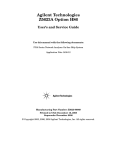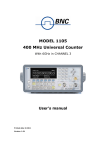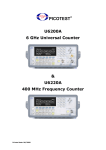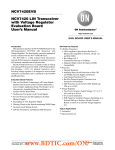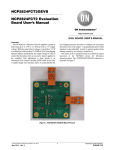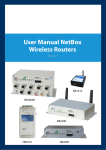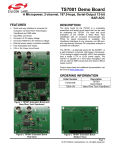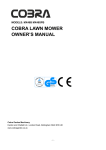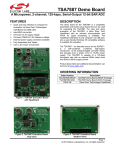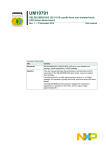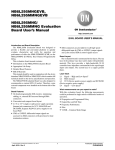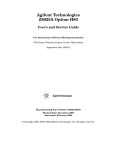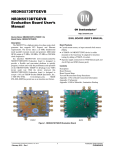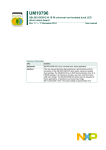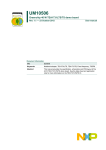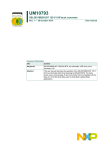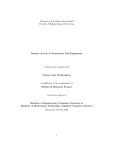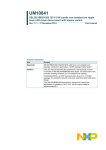Download EMI TSOP6 EVB Universal Evaluation Board User`s Manual
Transcript
EMITSOP6EVB EMI TSOP6 EVB Universal Evaluation Board User's Manual Board Description http://onsemi.com The EMI TSOP6 EVB universal Evaluation Board was designed to provide a flexible and convenient platform to quickly evaluate, characterize and verify the performance and operation of all twelve NB2XXXA EMI devices, and all of their possible configurations. This user’s manual provides detailed information on board contents, layout and its use. It should be used in conjunction with the appropriate NB2XXXA datasheet: (www.onsemi.com). See Table 1. EVAL BOARD USER’S MANUAL Board Features • Accommodates the Electrical Characterization of the • • • • NB2XXXA, Reduced EMI Series in the TSOP−6 Package Multiple Configurations − Refer to NB2XXXA Configurations Tables 1 and 2 26 W Series Termination Resistor Installed on MODOUT 15 pF Output Load Capacitor Installed on MODOUT Selectable Jumpers for SELECT Pin Logic Levels In or Out 1 6 VSS (GND) XO 2 5 MODOUT XI / CLKIN 3 4 VDD Twelve EMI products share the same TSOP−6 (TSOT−23−6) package, but have minor pin configuration differences. See Table 2. Figure 1. NB2XXXA TSOP−6 Pinout Figure 2. Evaluation Board © Semiconductor Components Industries, LLC, 2011 August, 2011 − Rev. 1 1 Publication Order Number: EVBUM2034/D EMITSOP6EVB Table 1. NB2XXX PIN FUNCTION (see datasheet) EMI Device fin (MHz) XTAL CLKIN (External) PD SSON Mod Eqn Freq. REFOUT NB2579A 13 − 30 Y Y N Y fin ÷ 640 $1% N NB2669A 6 − 13 N Y Y N fin ÷ 256 $1% N NB2760A 6 − 13 Y Y Y N fin ÷ 256 $0.75% N NB2762A 6 − 13 Y Y Y N fin ÷ 256 −1.25% N NB2769A 6 − 13 Y Y Y N fin ÷ 256 $1% N NB2779A 13 − 30 Y Y Y N fin ÷ 640 $1% N NB2780A 30 − 50 Y Y Y N fin ÷ 1280 $0.75% N NB2869A 6 − 13 Y Y N N fin ÷ 256 $1% Y NB2870A 13 − 30 Y Y N N fin÷640 $0.75% Y NB2872A 15 − 30 Y Y N N fin ÷ 640 −1.25% Y NB2879A 15 − 30 Y Y N N fin ÷ 640 $1% Y NB2969A 6 − 13 Y Y N N fin ÷ 256 $1% Y, REFOUT ÷2 Table 2. NB2XXX PIN ASSIGNMENT (see datasheet) EMI Device Pin 1 Pin 2 Pin 3 Pin 4 Pin 5 Pin 6 See Table 4 NB2579A I XO XI / CLKIN VDD MODOUT VSS (GND) R1 = 0 W NB2669A I NC CLKIN VDD MODOUT VSS (GND) R1 = 0 W NB2760A I XO XI / CLKIN VDD MODOUT VSS (GND) R1 = 0 W NB2762A I XO XI / CLKIN VDD MODOUT VSS (GND) R1 = 0 W NB2769A I XO XI / CLKIN VDD MODOUT VSS (GND) R1 = 0 W NB2779A I XO XI / CLKIN VDD MODOUT VSS (GND) R1 = 0 W NB2780A I XO XI / CLKIN VDD MODOUT VSS (GND) R1 = 0 W NB2869A O XO XI / CLKIN VDD MODOUT VSS (GND) R1 = 26 W NB2870A O XO XI / CLKIN VDD MODOUT VSS (GND) C1 NB2872A O XO XI / CLKIN VDD MODOUT VSS (GND) C1 NB2879A O XO XI / CLKIN VDD MODOUT VSS (GND) C1 NB2969A O XO XI / CLKIN VDD MODOUT VSS (GND) C1 http://onsemi.com 2 EMITSOP6EVB LAB SETUP PROCEDURE Lab Setup and Measurement Procedure Power Supply Equipment Used • Agilent Signal Generator #81110A (or Crystal) • Real−Time Oscilloscope, Frequency Counter or • • +3.3 V + Spectrum Analyzer Agilent #6624A DC Power Supply Digital Voltmeter − GND VDD Power Supply Connections The NB2XXXA has a positive supply pin, VDD, and a negative supply pin, GND. Power supply “anvil” terminals are provided for VDD and GND. Use of “minigrabber” banana plug cables work well for connections to the power supply. +3.3 V Figure 3. Power Supply Configuration Table 3. POWER SUPPLY CONFIGURATIONS Device Pin Single Power Supply VDD VDD = +3.3 V GND GND = 0 V In or Out Real Time Oscilloscope Spectrum Analyzer or Frequency Counter MODOUT Crystal Signal Generator LVTTL Out or CLKIN Figure 4. Input / Output Configuration http://onsemi.com 3 Hi−Z EMITSOP6EVB NB2XXXA If Pin 1 is an output, C1 can be used to install an output load capacitor, ie. a 15 pF capacitor. C1 and C3 can be used to parallel two output load capacitors. Also, a 26 W series termination resistor should be installed at R1. When Pin 1 is an input, the select header pins, HI and LO, can manually control the Pin 1 logic level via the appropriate jumper/shunt. A connection from each header must then be made to the Pin 1 metal trace. When either HI or LO are jumpered, Pin 1 is forced to VDD (logic High) or GND (logic Low). Lab Test Set−up Procedure To monitor the MODOUT output on an oscilloscope, spectrum analyzer or frequency counter: 1. Connect a power supply to the evaluation board. (see Figure 3) Connect VDD to +3.3 V Connect GND to 0 V 2. Connect an external clock reference to the CLKIN Pin 3 or install a crystal and appropriate (see CLKIN) crystal load capacitors to Pins 2 and 3. 3. Connect the MODOUT output to the measurement instrument. 4. For the MODOUT output, the NB2XXXA board provides a series 26 W source termination resistor and a load capacitor pad for each output; 15 pF is installed. MODOUT Output Series Resistor An R2 resistor pad is provided to series terminate the MODOUT output and is installed with a 26 W resistor. This series resistor complements an internal 24 W resistor to match the 50 W trace impedance. MODOUT Output Load Capacitor An output load capacitor pad is provided to load the MODOUT output and is installed with a 15 pF capacitor. C4 and C5 can be used to parallel two output load capacitors for various combinations of capacitive loads, if needed. Board Layout The evaluation board is constructed with FR4 material and 50 W trace impedance, designed to minimize noise and crosstalk. CLKIN An SMA connector is provided for CLKIN if an external clock source is used on Pin 3. The metal trace at the crystal pad is intentionally open for crystal use, and must be shorted for a connection to Pin 3 for external clock use. The unused component pad labeled C6 (used for the crystal load capacitor) may be used for a 50 W resistor to ground to terminate a signal generator. Layer Stack L1 L2 L3 L4 Signal (top) Ground VDD (positive power supply) Blank (bottom) Pin 1 − IN / OUT Configuration Pin 1 of the EMI TSOP6 EVB universal evaluation board can be configured to serve as an input or output, depending on device. See Tables 1 and 2. An SMA connector is provided to access Pin 1. If Pin 1 is an input, a 0 W resistor may be used at R1. Table 4. PIN 1 INPUT/OUTPUT Device Pin #1 R1 C1 (or C3) See Table 2 Input 0W Open See Table 2 Output 26 W 15 pF http://onsemi.com 4 EMITSOP6EVB NB2XXXA Output Loading VDD Series Termination Resistor Clock output traces over one inch should use series termination. To series terminate a 50 W trace (a commonly used trace impedance), place a 26 W resistor in series with the clock line, as close to the clock output pin as possible. The nominal impedance of the clock output is 24 W. Hi−Z Probe−to−Scope NB2XXXA RS = 26 W MODOUT Zo = 50 W Rint = 24 W CLoad Figure 5. Output Loading for Test / Evaluation In or Out 1 SMA VSS (GND) 6 Out VSS (GND) 2 5 SMA 0.1 mF SMA 3 CLKIN Small Gap Here for Crystal Use; Short for External Clock Source VSS (GND) 4 VDD VSS (GND) Figure 1. NB2XXXA Evaluation Board Schematic Table 5. NB2XXXA EVALUATION BOARD BILL OF MATERIALS Component Description Qty SMA 1 − 3 Connector SMA Connector 1−3 C2 Capacitor 0.1 mF, 10%, KEMET, C0603C104K5RAC, Installed 1 C6 − C7 Capacitor (Crystal Load) 27 pF, Not Installed 2 C1, C3, C4, C5 Capacitor 15 mF, C5 Installed 1−4 Jumper Header 100 mil, Berg 4 Jumper 2 R1 − R2 Resistor 26 W or 0 W, R2 Installed with 26 W 2 C6 Resistor (optional) 50 W, 0.1%, 0.25 W 1 Power Supply Connector Anvil − Keystone #5016 2 U1 NB2XXXA TSOP−6 device (Installed by User) 1 X1 Crystal (See Crystal Chart) Fundamental Mode, Parallel Resonant, Ecliptek www.ecliptek.com 1 Pin Recepticle Through−Hole Crystal Connector 2 Capacitor VDD to GND Bypass Capacitors http://onsemi.com 5 10 mF − 22 mF 0.01 mF − 0.1 mF 1 1 EMITSOP6EVB Table 6. Table 7. Crystal Frequency (MHz) Ecliptek Part # ESR (W MAX) 6.000 ECX−6074−6.000M 125 8.000 ECX−6075−8.000M 10.000 Crystal Parameter Specification Nominal Frequency See Chart Frequency Tolerance at 25°C/ Stability over OTR ±15 ppm / ±20 ppm 70 ECX−6078−10.000M 50 Operating Temperature Range 0°C to +70°C 12.000 ECX−6081−12.000M 50 Load Capacitance (CL) 18 pF 13.500 ECX−6082−13.500M 50 See Chart 14.31818 ECX−6083−14.31818M 50 Equivalent Series Resistance (W) (Maximum) 15.000 ECX−6084−15.000M 50 Mode of Operation and Crystal Cut AT−Cut Fundamental 16.000 ECX−6087−16.000M 50 Storage Temperature −40°C to +85°C 16.660 ECX−6090−16.660M 50 Drive Level 18.750 ECX−6125−18.750M 50 100 mWatts Correlation 1 mW Maximum 19.440 ECX−6091−19.440M 50 Aging (at 25°C) 19.531 ECX−6126−19.531M 50 ±3 ppm / 1st year, ±15 ppm / 10 year Maximum 20.000 ECX−6094−20.000M 50 Insulation Resistance 500 MW Minimum,100 V 20.1416 ECX−6127−20.1416M 50 5 pF Maximum 20.480 ECX−6099−20.480M 50 Shunt Capacitance (pF (Maximum) 24.000 ECX−6102−24.000M 40 Package E2S (HC−49/UP SMD) 25.000 ECX−6105−25.000M 40 26.5625 ECX−6110−26.5625M 40 26.6000 ECX−6128−26.6000M 50 27.000 ECX−6115−27.000M 40 28.000 ECX−6118−28.000M 40 30.000 ECX−6119−30.000M 40 32.000 ECX−6120−32.000M 40 ON Semiconductor and are registered trademarks of Semiconductor Components Industries, LLC (SCILLC). SCILLC reserves the right to make changes without further notice to any products herein. SCILLC makes no warranty, representation or guarantee regarding the suitability of its products for any particular purpose, nor does SCILLC assume any liability arising out of the application or use of any product or circuit, and specifically disclaims any and all liability, including without limitation special, consequential or incidental damages. “Typical” parameters which may be provided in SCILLC data sheets and/or specifications can and do vary in different applications and actual performance may vary over time. All operating parameters, including “Typicals” must be validated for each customer application by customer’s technical experts. SCILLC does not convey any license under its patent rights nor the rights of others. SCILLC products are not designed, intended, or authorized for use as components in systems intended for surgical implant into the body, or other applications intended to support or sustain life, or for any other application in which the failure of the SCILLC product could create a situation where personal injury or death may occur. Should Buyer purchase or use SCILLC products for any such unintended or unauthorized application, Buyer shall indemnify and hold SCILLC and its officers, employees, subsidiaries, affiliates, and distributors harmless against all claims, costs, damages, and expenses, and reasonable attorney fees arising out of, directly or indirectly, any claim of personal injury or death associated with such unintended or unauthorized use, even if such claim alleges that SCILLC was negligent regarding the design or manufacture of the part. SCILLC is an Equal Opportunity/Affirmative Action Employer. This literature is subject to all applicable copyright laws and is not for resale in any manner. PUBLICATION ORDERING INFORMATION LITERATURE FULFILLMENT: Literature Distribution Center for ON Semiconductor P.O. Box 5163, Denver, Colorado 80217 USA Phone: 303−675−2175 or 800−344−3860 Toll Free USA/Canada Fax: 303−675−2176 or 800−344−3867 Toll Free USA/Canada Email: [email protected] N. American Technical Support: 800−282−9855 Toll Free USA/Canada Europe, Middle East and Africa Technical Support: Phone: 421 33 790 2910 Japan Customer Focus Center Phone: 81−3−5773−3850 http://onsemi.com 6 ON Semiconductor Website: www.onsemi.com Order Literature: http://www.onsemi.com/orderlit For additional information, please contact your local Sales Representative EVBUM2034/D






